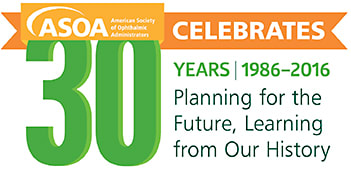My Back Page
Society celebrates 30 years
A timeline shows ASOA’s rich history and dedication to excellence in practice management — today and tomorrow.
BY LAUREEN ROWLAND, CAE

This year, the American Society of Ophthalmic Administrators (ASOA) celebrates 30 years of advancing the skills and professionalism of ophthalmic practice management. Below, I touch on the milestones that helped shape those 30 eventful years.
1986. Lucy Santiago, a consultant for an ophthalmology practice in Long Beach, CA, approaches the American Society of Cataract & Refractive Surgery (ASCRS) with a novel idea: Include a workshop for administrators during the Society’s annual Symposium. The workshop, “The 24-Hour Administrator,” was presented to a full room. Shortly thereafter, ASOA was created as a division of ASCRS. Ms. Santiago was appointed executive director, a position she held until 2005.
1987. ASCRS and ASOA hold their first joint meeting in Orlando, FL.
1990. The first ASOA Board of Directors is formed. E. Q. “Skip” Fahel is appointed president.
1992. Administrative Ophthalmology magazine launches. Publisher David Karcher writes that Administrative Ophthalmology “will be filled with information specific to all facets of ophthalmic practice management.”
1994. Thirty-nine administrators attend “Wharton 1,” an executive management program at the University of Pennsylvania’s Wharton School of Business. This led to the development of the Certified Ophthalmic Executive (COE) credential.
1996. Administrative Ophthalmology is rebranded Administrative Eyecare.
1999. One hundred six individuals pass the first COE exam administered. More than 300 individuals now hold this elite designation.
2000. The ASOA list serve, EyeMail, debuts. The online forum allows ASOA members to interact with each other for solutions to practice management challenges. In 2016, EyeMail remains ranked as one of the top ASOA member benefits.
2007. ASOA adopts the tagline, “Focusing on the Business of Ophthalmology.”
2008. “The Pinnacle Award” was established to recognize efforts to eliminate potential abusive billing practices and maintain compliance with government regulations. The award was established in honor of William E. Rose, Jr.
2010. The “Pinnacle Award” is renamed “The Pinnacle Award for Volunteerism” to recognize contributions for the advancement of practice management skills and professionalism.
2013. ASOA conducts its first “EHR Customer Satisfaction Survey” to assess the ability of systems to meet meaningful use reporting requirements. The survey was updated in 2015.
2014. ASOA launches online education, the “ASOA Learning Center,” in conjunction with BSM Consulting. The center is a suggested study resource for COE exam preparation. It also offers continuing education and professional development opportunities.
2014. The annual Administrative Eyecare “Editor’s Choice Award” is introduced to honor AE contributors.
2015. ASOA rolls out its “ASOA on Tour” regional educational meeting program with meetings in Austin, TX, Philadelphia, PA, and Orlando, FL.
2015. The Society publishes the “Technician Workup Survey” in conjunction with BSM Consulting and Eyetechs. This survey uses data from 6,319 patients encounters to determine whether electronic records contribute to longer patient workup durations.
2016. ASOA celebrates its rich history while looking to the future — developing resources to address regulatory and legislative mandates, evolving medical technologies, the rise in mergers and consolidations, and shifts in traditional recruiting, staffing, and human resources practices. OP

|
Ms. Rowland has more than 30 years of experience in association management. In her role as ASOA executive director, she manages the business, operational, and strategic aspects of the Society. |








